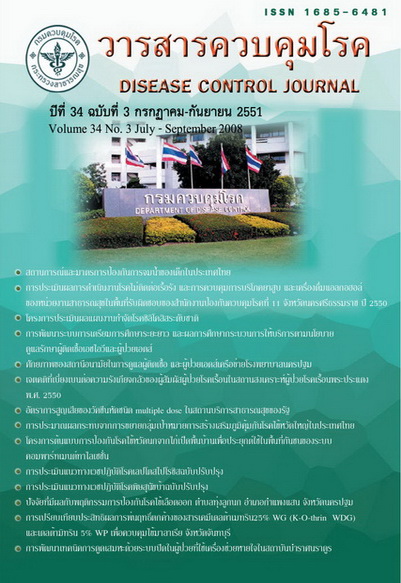Model Development of Prevention and Control Avian Influenza in Backyard Duck and Chicken Applying for Compartment Alisation System
Keywords:
AI Prevention and Control, Compartment Alisation SystemAbstract
The study aimed to develop a model, focusing on community participation for the prevention and control of AI in backyard ducks and chickens. The model was applied in the buffer zone of compartmentalization system. The study area was divided into two groups, experiment and control and was conducteds between August 2006 and August 2007. Pre- and post-experimental data were collected. Data included of knowledge and information-perceiving behavior among community leaders, people and school children; examination for virus in droppings of backyard chicken and duck. Learning process was divided into two groups, community leaders and school teachers, using Future Search Conference (F.S.C. technique) as a group dynamic. It was found that communities had been motivated by community leaders who continuously kept an eye on and prevent AI in communities following the six measures, namely, poultry raising, limitation in number of poultry, poultry movement, reporting of sick or dead birds, social restriction and human case reporting. Chicken keepers began to raise chicken within the vicinity of their houses. Community leaders and backyard chicken keepers co-operated in AI prevention by surveying and registering poultry, record in front of each pen, reporting of sick or dead birds, installing net around backyard, forming cock-fighting groups and backyard chickenraising groups, setting up flu database in communities, issuing AI newsletter for volunteers, set up AI information center in Tambon, developing local curriculums regarding AI in schools and backyard chicken raising, collecting of local wisdoms on useful herbs by non-formal education teachers. It was also found that pre- and post-participatory learning process among community leaders had high knowledge and understanding about AI, high practice in self-protection and high disease surveillance and control. People had a good level in knowledge and understanding, self-protection behavior and participation. They raised poultry more carefully than pre-experimental period. Significantly, school children had better knowledge and understanding, and better self-protection behavior than the pre-experimental period. Examinations for H5N1 in both pre- and post-experiments found no virus. The results revealed that building of participatory learning process helped increase knowledge and understanding of community leaders and people. Therefore, they had participated in AI prevention and control. However, they had to have their goals in common. Together, they had set up the action plan and understood the steps of operation. They should support each other as well as giving willpower, receiving training and keep on monitoring. Knowledge achievement was a crucial element in building of participatory learning process. This model wass an alternative that could be applied to establish biosecurity in buffer zone.
References
2. สำนักระบาดวิทยา กรมควบคุมโรค. สรุปรายงานการเฝ้าระวังโรคปี 2548. โรงพิมพ์องค์การรับส่งสินค้าและพัสดุภัณฑ์, 2548
3. จุฑารัตน์ ถาวรเจริญ และคณะ. บทคัดย่อผลงานวิชาการนำเสนอในการประชุมวิชาการกระทรวงสาธารณสุข. ประจำปี 2549 วันที่ 4-6 กันยายน 2549 ณ โรงแรมปรินซ์ พาเลช กรุงเทพมหานคร
4. สำนักควบคุมป้องกันบำบัดโรคสัตว์ กรมปศุสัตว์ กระทรวงเกษตรและสหกรณ์. คู่มือความปลอดภัยทางชีวภาพ การทำฟาร์มไก่และเป็ดเนื้อ เพื่อเข้าสู่ระบบ Compartmentalisation. 2548
5. พิมพ์พรรณ ศิลปสุวรรณและคณะ. วิธีวิจัยในงานสาธารณสุข. โรงพิมพ์วิทูรย์การปก, กรุงเทพมหานคร 2538
6. ทวีศักดิ์ นพเกสร. วิกฤติสังคมไทย 2540 กับบทบาทวิทยากรกระบวนการ เล่มที่ 1 2541
7. เสรี พงศ์พิศ. เศรษฐกิจพอเพียงการพัฒนาที่ยั่งยืน. เจริญวิทย์การพิมพ์, 2546
8. อุษา เทียนทอง. เอกสารเสริมการเรียนการสอนนักจัดการความรู้สร้างกระบวนการเรียนรู้ชุมชนพึ่งพาตนเอง. กรุงเทพมหานคร เจริญวิทยาการพิมพ์ 2550
Downloads
Published
How to Cite
Issue
Section
License
Articles published in the Disease Control Journal are considered as academic work, research or analysis of the personal opinion of the authors, not the opinion of the Thailand Department of Disease Control or editorial team. The authors must be responsible for their articles.



.png)



